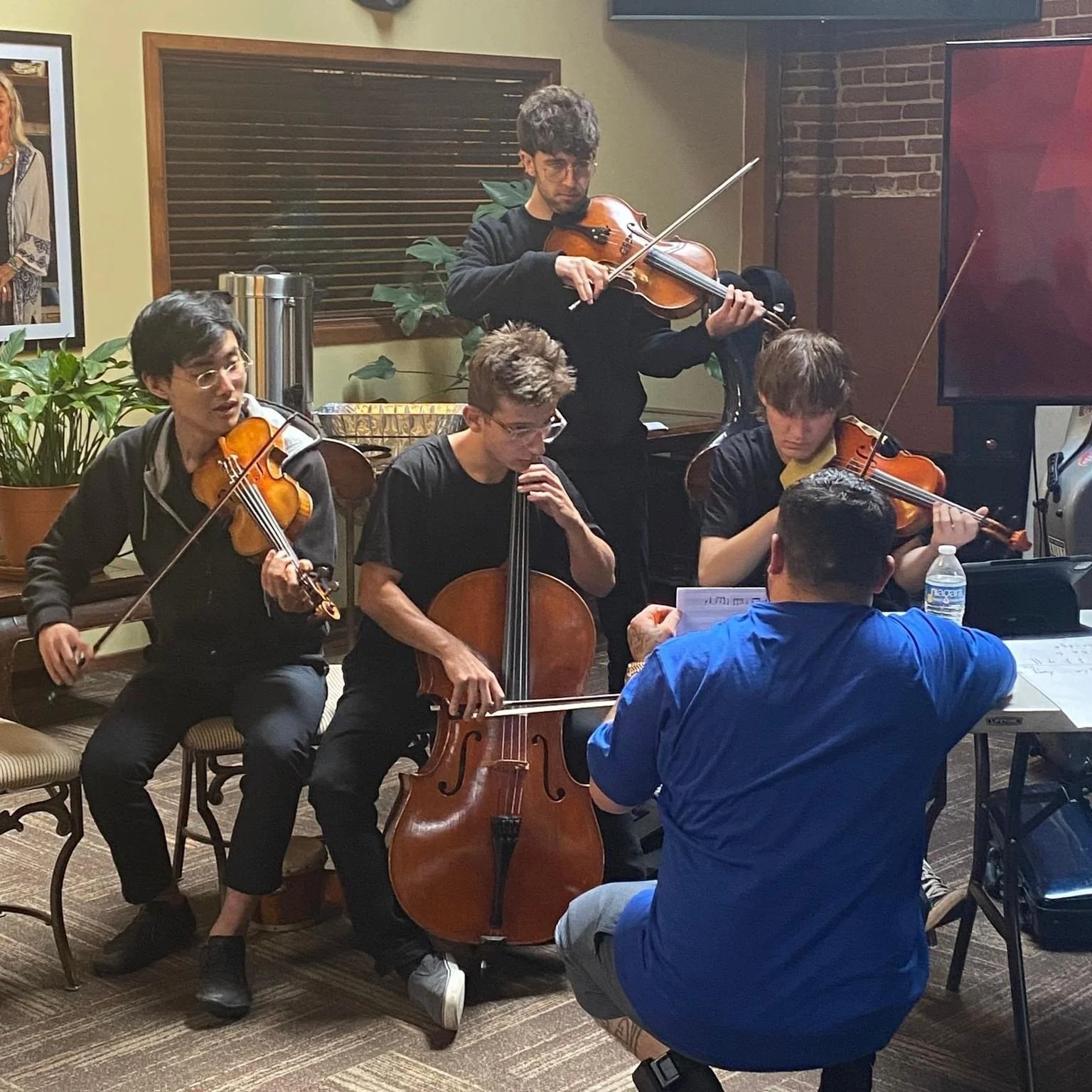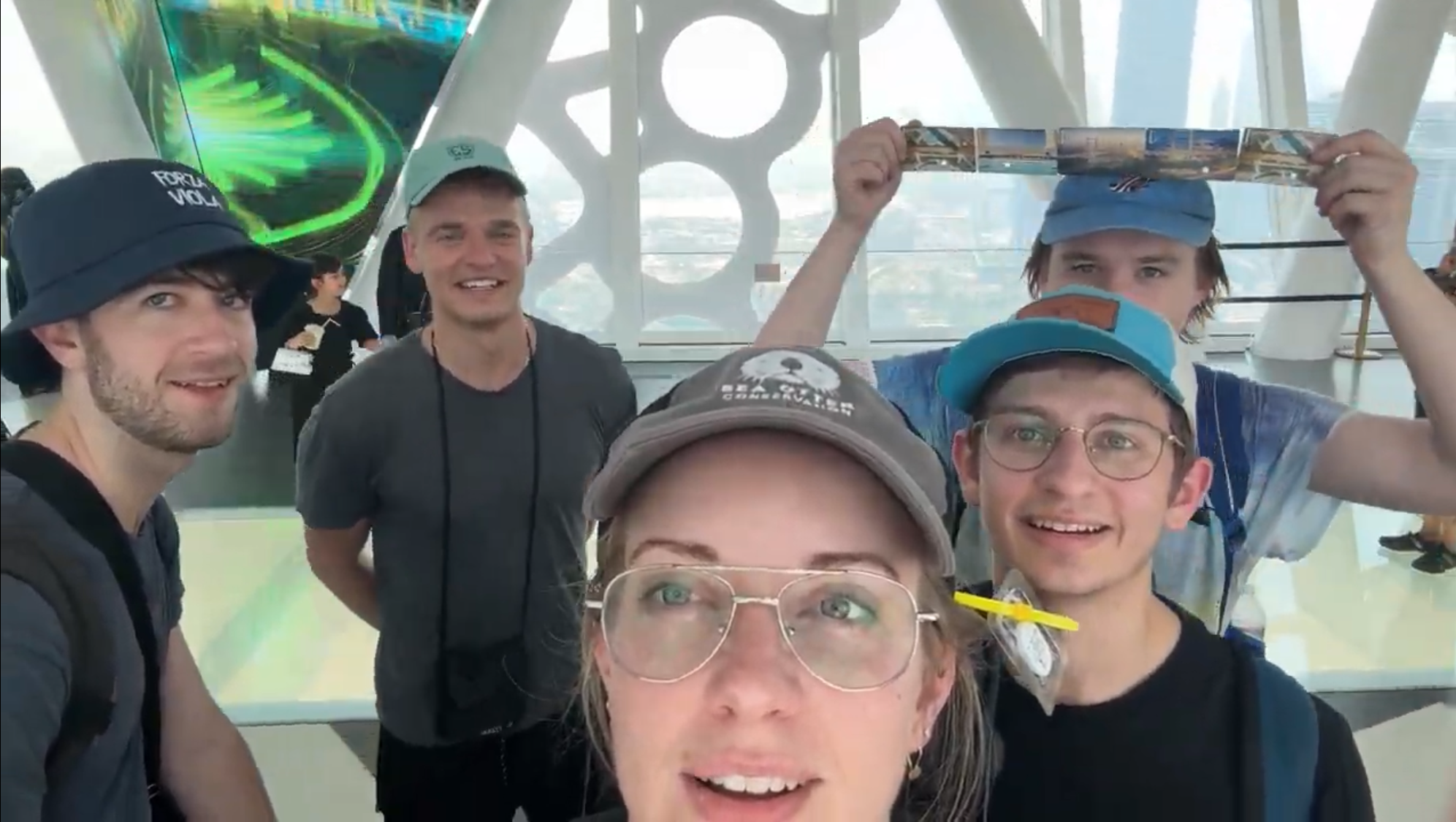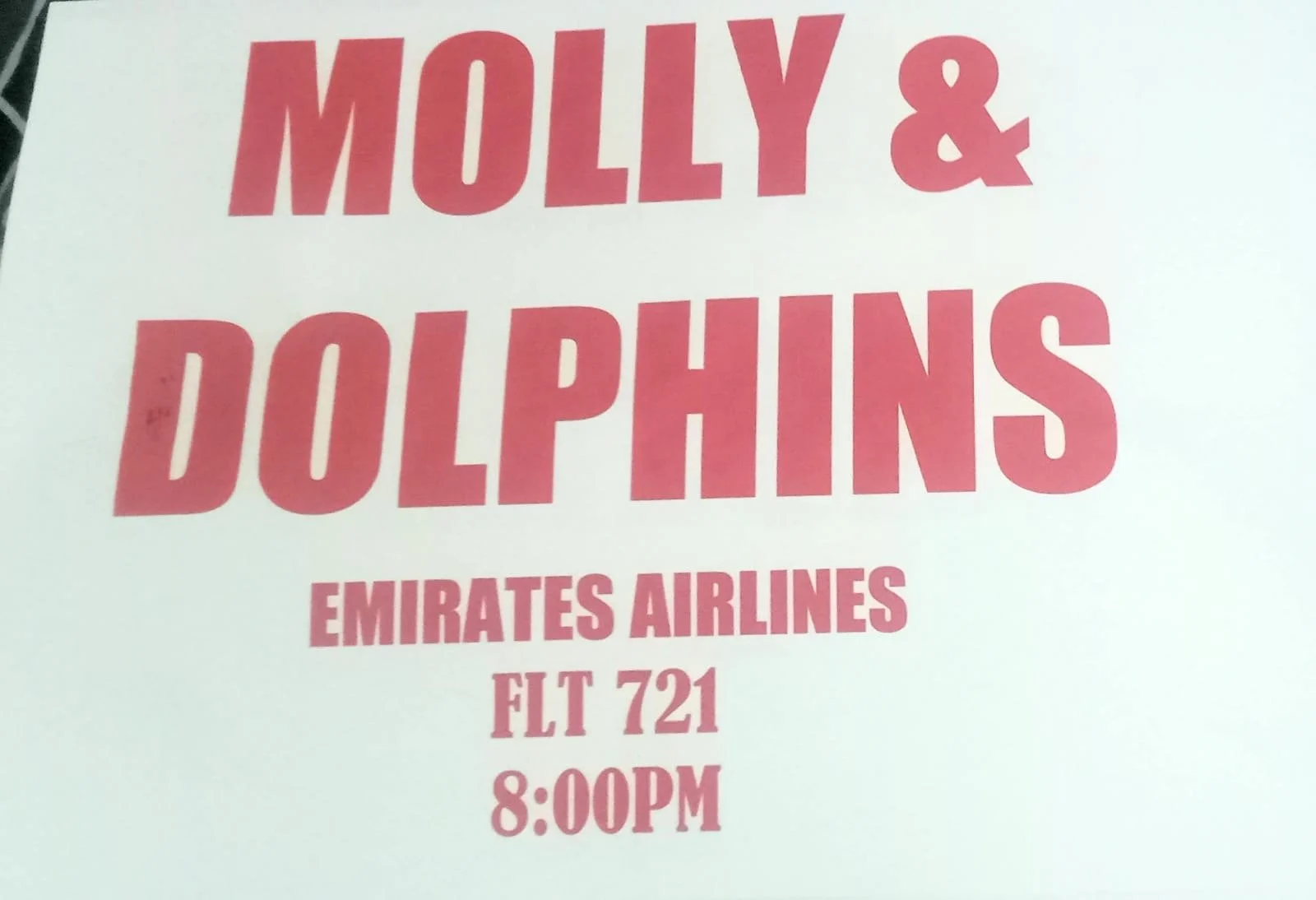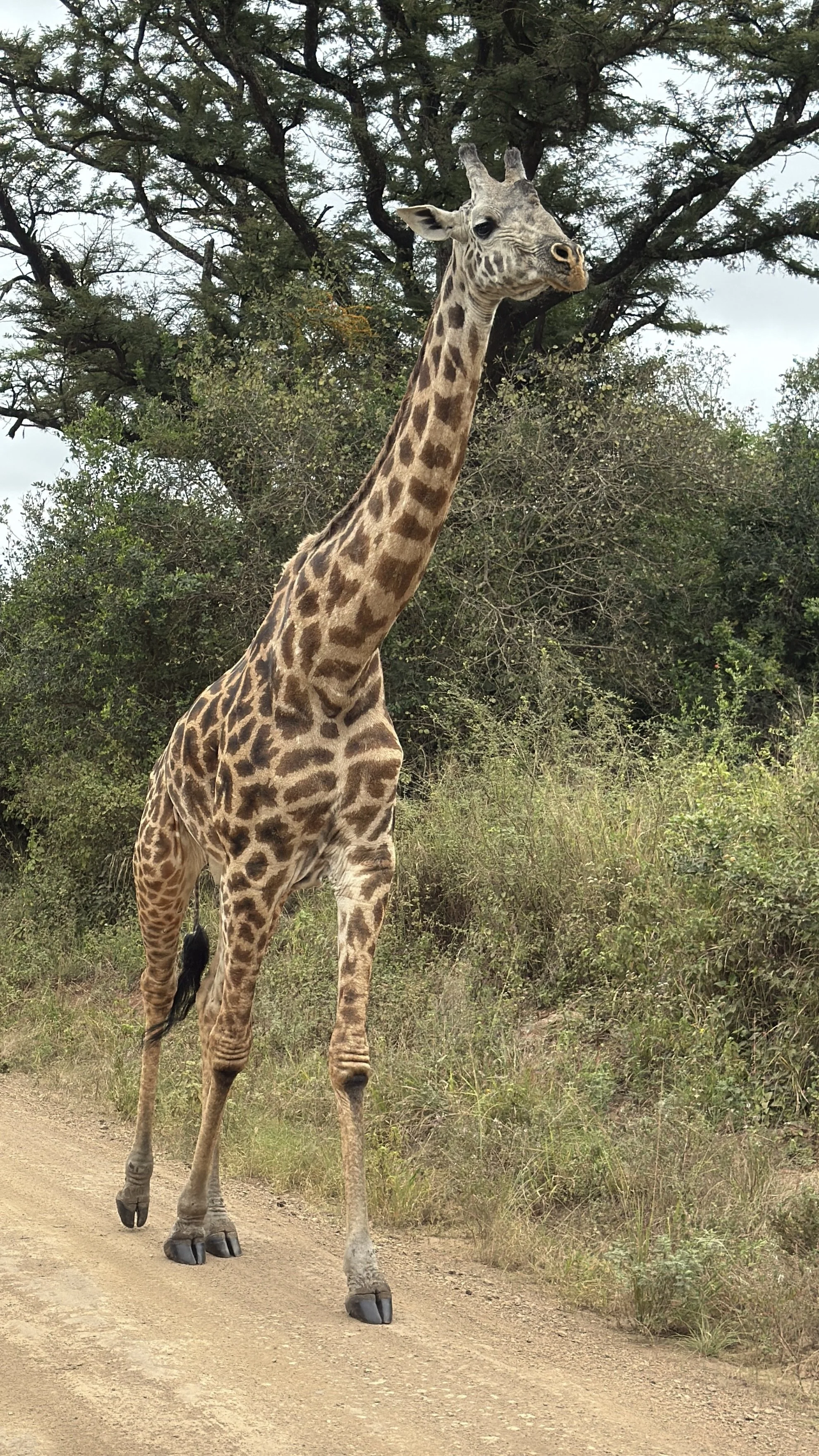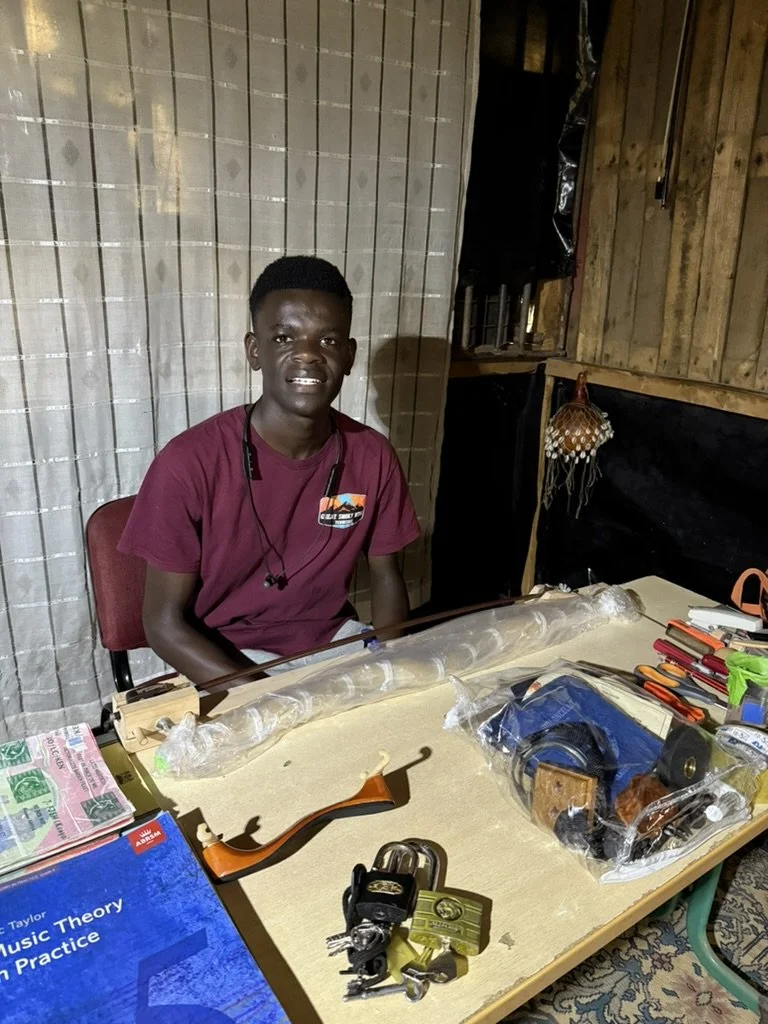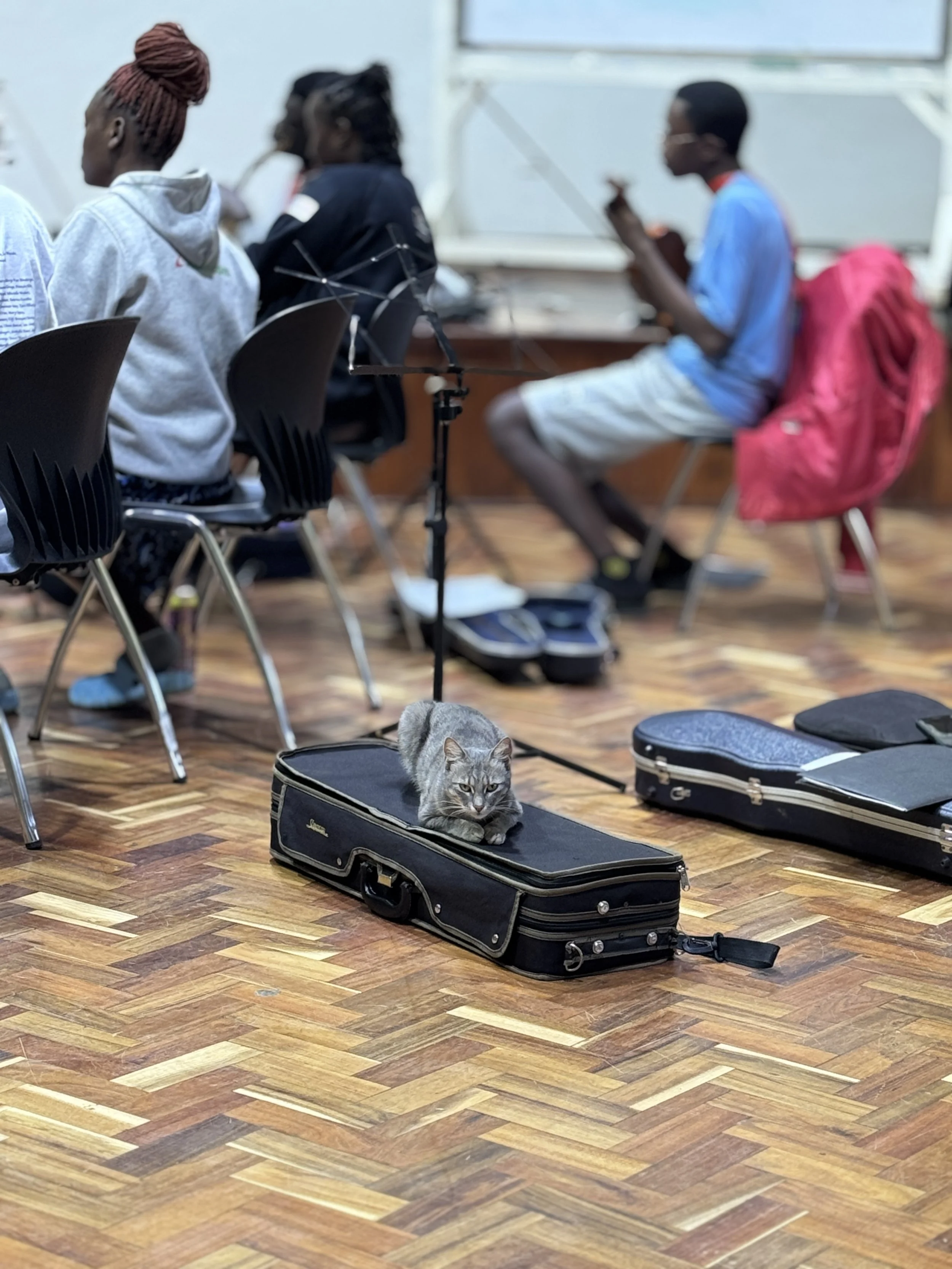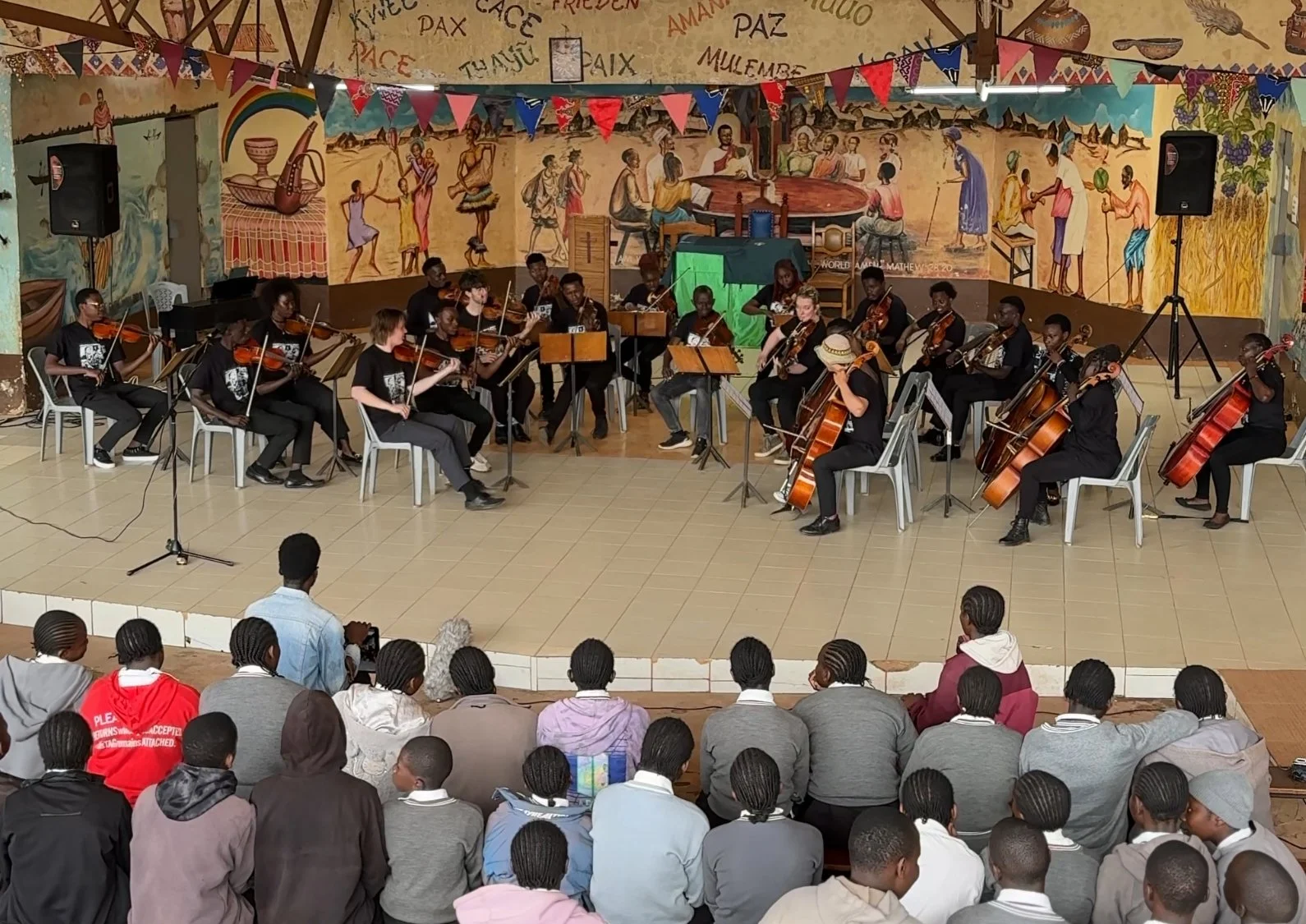The Dolphins in Kenya
By James Preucil
Edited by Dana Martin, Theresa Ja-Young Kim, and Ian Maloney
The Dolphins with Peter Dudek, Molly Carr, and our cohort of Ghetto Classics students! (Photo Credit: Jessica Lynn)
As of writing this, it has been 11 days since our small team of string players at Molly Carr’s apartment in Manhattan: myself (James), Ian, and Luke from The Dolphins Quartet; Peter Dudek (violist of the Ulysses String Quartet), and Molly Carr (violist and artistic director of Project Music Heals Us). We were preparing ourselves for a cross-continental journey that was difficult to wrap our heads around. Now, on the second leg of a 20+ hour plane-flight back home, it feels like those 11 days have passed like a bright flash of lightning; the kind that leaves you blinking and disoriented but with a deep sense of awe.
I. Getting to get to Kenya
About 3 years ago, when we were first starting out as a string quartet, we had two main ambitions:
Go to Africa
Go to the moon
Neither seemed very attainable at the time—we were just dreaming that we would get to travel far and see new things while playing lots of music. That was before violist, entrepreneur, and humanitarian Molly Carr put her faith in us to become part of her non-profit organization, Project: Music Heals Us (PMHU). She coached us as a group early in our journey and somehow, we made a good enough impression for her to believe that our personalities and musical skills would fit a new program she was developing called Music For The Future. In September 2023, we found ourselves in California, co-teaching a composition course in a re-entry program and a county jail. Our lives were already changed forever after those two weeks of meeting people who came from backgrounds full of difficulty and struggle that had never affected us.
The Dolphins at our first Music For The Future residency in September 2023 (Photo Credit: Dana Martin)
This experience made us rethink the purpose and power of music, and it brought us much closer as a group. But for me, the things I’ve learned about life and music in the past 11 days outshine all the previous experiences I have had tenfold and I am sure all of my colleagues and friends feel similarly.
I don’t remember exactly when we first heard that we would be going to Kenya; it was probably the spring of 2024, but it was difficult to wrap our heads around the idea at that point. The plan was for us to lead a 10-day camp/festival in Nairobi at the Ghetto Classics foundation during August of that year. At first, it felt too good to be true. As summer progressed and we began getting our numerous travel vaccines, it slowly started to become reality. We met our students for the first time on Zoom in July of that year. The connection was choppy at best and we often struggled to hear our students playing or speaking. I can’t imagine it was easy for them to understand us either! We could sense, though, that these students were eager to learn as much as they possibly could about music which they showed through continuous patience as we worked together to overcome technological difficulties.
Just weeks before departure, we were all heartbroken to cancel the trip: political unrest in Kenya would have made it unsafe for us to be there and for the students to attend due to political riots. Many students walk to the Ghetto Classics school facilities, some from miles away. It was a strange feeling to lose an opportunity that we had not even fully processed yet, and equally as confusing for our students. We continued teaching lessons on Zoom and rescheduled the trip for November but the second blow fell just as hard when we cancelled our second attempt for similar reasons as the first. Continuing lessons over Zoom when we had twice promised our students that we would be there with them was discouraging. We took a break from lessons during December to reevaluate the direction of our program.
In early 2025, we had newfound hope as we scheduled travel to Nairobi in July. Lessons became more consistent with clearer direction. We found that, despite the difficulties, we had begun forming cross-continental friendships with our students. As for me, I gained more confidence in my ability to teach as I saw my students start to progress, little by little, each week. Over the course of the rest of the school year, we hoped with all our hearts that we would finally get to meet our students in-person in Nairobi.
One concern that gradually arose was about our violinist, Isaac, whose health was more affected by travel than the rest of us, often reacting more aversely to sicknesses, exhaustion, and bug bites. After much discussion we all agreed it would be best for Isaac to stay home while we ventured across the ocean. Luckily, Peter Dudek, violist of the Ulysses String Quartet, had been teaching our students in a theory class and he was thrilled to step in as the other violin teacher and violinist for this trip. We had performed with him before and were thankful that he fit into place so smoothly.
II. On our way to Kenya
The months slowly passed with anticipation. We felt that it was imperative for us not to let our students down for the third time, but we also knew that the factors allowing us to travel there were completely out of our control. Finally, we woke up on July 1st and left our New York apartments, passports and luggage in hand. It was difficult to process and believe that we were finally going to Kenya (“Ken-ya believe that?” I often quipped to people when I told them about our trip).
Our team in an Uber to JFK! (Photo Credit: Molly Carr)
With a mix of anticipation and excitement, we journeyed to JFK airport, through security, and onto a huge Fly Emirates plane with 3 aisles and multiple floors. Our team included:
3 Dolphins: Luke Henderson on violin, James Preucil on viola (me!), and Ian Maloney on cello
Peter Dudek, aforementioned violist moving to violin for the trip
Molly Carr, founder and director of PMHU
(2 more would be joining us when we arrived in Nairobi)
The Airbus A380 is the biggest passenger plane in the world, and can carry up to 853 passengers! Emirates is the largest operator of this aircraft type, and my experience on this plane was top-notch! It was much quieter than any jet I had been on, and the food was great! -Ian, resident transportation enthusiast
It was an excellent collection of individuals to travel with; full of wit and curiosity. After a 15-hour flight, we had an 8-hour layover in Dubai and elected to leave the airport to see the city while we were there. Ian and I fell victim to a bad deal in the Dubai market, overpaying by at least $120 for poor-quality pants. I learned from this mishap and bargained with a sandal merchant to get his price down by about 40%. I still overpaid but it was worth the experience. We also visited The Frame of Dubai: a massive rectangular structure from which we had an excellent view of the city.
Our team at The Frame of Dubai (Photo Credit: Molly Carr)
We continued on with a 6-hour flight to Nairobi. The feeling was immediately different upon touchdown. The pace was slower and more relaxed as we sleepily but excitedly ambled through the airport. Through baggage claim and customs, people were friendly and courteous. In the airport, we joyfully met with the final two members of our team:
Jessica Boykin, Operations Director for PMHU
Theresa Ja-Young Kim, a communications professional and former pianist who previously ran a program that partnered with Ghetto Classics
III. Exploring Kenya
At arrivals, we found a friendly pair of drivers holding a sign that read:
Photo Credit: Theresa Ja-Young Kim
They drove us to our hotel, a beautiful building called The Tribe. It was filled with statues, artwork, and novel furniture in traditional Kenyan style—we were starting to feel like we were really on a different continent. The Tribe was incredibly hospitable; our arrangement was 5 nights of lodging in exchange for a concert at the end of our stay. I felt that they understood we were there to offer inspiration and opportunity for a part of their community.
We woke up in a disoriented state early the next morning to drive through a safari at the Nairobi National Park (the only one within a city in the whole country. Our driver guided us through a national park full of animals we had heard of our whole lives but had never seen in their natural state. First, we saw guinea fowl with green-white spots and herons richly colored in shades of blue and purple. We saw a small herd of impalas; lithe creatures that looked like real-life reindeer, packs of vividly-striped zebras, a rare black rhino with a razor sharp horn, concerningly large ostriches, and mighty-looking giraffes.
Photo Credit: Molly Carr
We found ourselves remarkably close to a lion, mane and all, as it nonchalantly padded along through an eager posse of tourist-filled vans. In a parking area, I eased myself within 2 feet of a miniature monkey! We observed crocodiles and hippos lurking in a small pond. Finally, we visited a sanctuary for orphaned baby elephants.
We were already exhausted from a morning of wonders but it was time for us to lock in. We grabbed plastic containers from a small buffet and jumped in our car en route to our first Ghetto Classics location: a town called Korogocho. We came up with creative solutions to eat our lunch buffet boxes without plastic-ware (plasticware isn’t very common in Kenya due to an effort to reduce pollution). Unfortunately, we found ourselves stopped in bumper-to-bumper traffic.
Driving is chaotic in Nairobi. If I had to drive there, I would be confused and paralyzed as cars zoomed around me, shooting for impossibly narrow gaps and tight timings that would cause an uproar even in New York City. While we were stuck, people came to our windows hoping to sell us trinkets. Others came asking for food. We had somehow over-ordered buffet boxes and Molly passed our extras out the window of the moving car.
IV. Ghetto Classics at Korogocho
I dozed off for a while during the traffic, and when I woke up, the architecture had changed from the modern, urban buildings to small, handmade structures, many of which seemed to be barely held together. The streets were bustling with people, an various of medium-to-small animals, and the occasional motorized vehicle. Everywhere, assortments of food, used electric items, and a wide variety of clothing were laid out or displayed for sale. Once again, I was in awe of how narrowly the van fit around people, other vehicles, animals, and tight corners. Everywhere I looked things seemed to be covered in a layer of red-brown dirt.
Is this really the right place? I wondered.
We turned into a gated entrance which opened to reveal hundreds of multi-aged children in various states of recess. Brimming with excitement, they waved and smiled at us as we drove in. They surrounded us and reached out their hands to touch our arms or give us soft high-fives. We immediately knew that we had found a magical community of people. That was when we finally met our students whom we had been teaching online for an entire year. I was a bit apprehensive about this, wondering what they would think when they finally met the nerdy white guy with messy hair from the other side of the zoom screen. My nerves were immediately eased as they greeted us with warm hugs, showing how excited they were for us to be there. A few students showed us around the facility, and we recognized the chaotically noisy rooms from our zoom lessons. Seeing their school in person, I was amazed that this place had any instruments and WiFi at all. Their music stands were heavy contraptions made of metal and wood, many of them off-balance and barely held together, and a collection of flimsy gray plastic chairs to go with them. But despite the budget-through-the basement state of things, there was an undeniable energy of hope and joy that persisted everywhere we went.
Finally, it was time to begin our musical exchange. Standing in a circle, we took turns singing our names with our own musical interpretations of them. One of my viola students performed his name with a crescendo and then a clap on the second syllable of his name: “Al-vin!” Throughout the rest of the festival, people cheered him on in the same way.
Our first topic of discussion was score study. We discussed how to mark up a score for a piece of chamber music and then we immediately put it into practice in our quartets. The group I coached included two students who were new to chamber music. Over the course of the hour, and with great attention to detail, we were able to make it through the first half of “The Two Grenadiers.” We ended rehearsal with an improvisation about a forest where we took turns making windy and branch-crackly sound effects or playing a melody.
The last event of the day was orchestra rehearsal. We began working on a Kenyan pop song called “Dezo Dezo” arranged by Ian. Having woken up before 6 AM after 20+ hours of flying, I was battling extreme jet lag and began nodding off while playing viola—everyone poked fun at me for this throughout the rest of the week. We ended our first day by whole-heartedly singing through the arrangement as a group.
Orchestra rehearsal on Day 1 in a room at the Korogocho music building (Photo Credit: Theresa Ja-Young Kim)
There was already so much to process after just one day of working with our students and seeing where they live, but we were very happy with how the first day went. Every student was giving it their all, and they eagerly jumped to participate in every activity. In transitions, the students would always help each other set up and figure out where to be making it easy for us to focus on teaching. They are extremely good-natured people, constantly bringing smiles, support, and enthusiasm.
We began Day 2 with a group songwriting session. We picked words to draw from to create a chorus: 5 animals, 5 foods, and 5 places. Then, we connected and combined them to create a 4-line chorus:
Dog eating chicken in Nairobi
Cat eating burger in Kilifi
In Molo, cobra eating fish chapati
Ocean birds eating misheveve
Meanwhile, Ian plucked some chords on his cello to get the music flowing. I then asked a student to speak the words of the first line, hoping just to find a rhythm. To my surprise, his speaking turned into singing and the whole class joined in. Just like that, we had pieced together a fantastic chorus.
The day continued with individual lessons. After struggling through a year of spotty WiFi signals and fleeting moments of good sound quality, being right next to my students for the lessons was a dream come true. Communication was so much easier, and I could demonstrate freely without holding myself at an awkward angle to fit in the camera screen. It was so much easier to diagnose technical issues and to explain how to improve them.
During our lunch break, we grabbed our dolphin frisbee and ventured out to the soccer field; a large, rectangular expanse of red-brown dirt surrounded on all sides by a tall fence. Just a few of our students joined us at first. More and more young kids from the school gathered around, brimming with curiosity. Eventually, the frisbee landed near the group of children and they all ran to get it, then they threw it back to us. This group of meter-tall children ended up taking over the frisbee game in an adorable fashion, begging for us to throw it to them over and over until it was time to play more music!
Photo Credit: James Preucil
The rest of the day continued in high spirits as we discussed sound production and continued with our quartet coachings and orchestra. We were once again thrilled with the students’ willingness to apply themselves and try new musical ideas. The difficulty of that second day was that as the hours passed, we noticed more and more a thick smokey smell filling the air. It made it difficult for us visitors to breathe, but our students seemed unbothered. At the end of the day, I asked a student if the air was always like this, and he said he didn’t notice anything that day. He then showed me out the back window of the school a massive garbage pile which he called “Dandora.” He explained that people in Korogocho search for items in the dump that they can resell in order to earn a living. We later learned from another student that it is nearly impossible for those people to get jobs due to limited access to education. Coming from a middle-class Illinois suburb, it was increasingly difficult and shocking to fathom what life must be like for people living in Korogocho, from the struggles of daily life to the health issues that residents must suffer from due to living right by a dump. Yet, as I say over and over again, the people there were the kindest individuals and community in the world, and in the middle of it all were these resourceful young adults spending hours each day gathering to play music.
V. Ghetto Classics at Mukuru
The next morning, we went to another Ghetto Classics location: a school in Mukuru, about an hour away from Korogocho. My car arrived early (the other group got briefly stuck in a ditch at the entrance), so I started to look around. A small child poked his head out from around a corner and whistled at me using his thumbs. I tried to do it back to him and failed, to his amusement. I went over and he taught me with the help of a few others until I got a sound using his technique. Then, some students from our program showed me to their music classroom. One student, Collins, proudly showed me his bow-rehair and repair shop, a trade which he had learned from a festival program a few years earlier.
Collins Odhiambo at his work station (Photo Credit: Theresa Ja-Young Kim)
Apparently, he single-handedly takes care of most luthier work for the Ghetto Classics program. I got out my viola and we started to have an impromptu jam session. We played a few bars of a Kenyan pop song called “Bwana Nipe Pesa” and then I played “Despacito” with two recorder prodigies.
Finally, the rest of the group arrived and the tour of Mukuru began. We visited one classroom at a time with groups of students learning an instrument. They had a room for seemingly every instrument in the orchestra. The tutors were super friendly, having their students demonstrate whatever they were working on. It was raining quite heavily and the weather was on the chilly side that morning, but the warmth of the children showing pure love and dedication to their craft shone clear as crystal, leaving us fascinated and inspired.
Out the windows, we could see the huts and shelters where the students ostensibly lived. But despite their homes looking much different than our childhood homes did in America, here they were playing and loving music with all of their spirit. At the conclusion of the tour, we saw the students play with gusto an arrangement of “The Barber of Seville” and in return, we played a Haydn quartet movement and some folk songs. I noted that through the whole interaction, the kids were especially quiet and respectful for their young ages. They were genuinely intrigued, listening to everything we played and every word we spoke.
The orchestra at Mukuru (Photo Credit: Jessica Lynn)
We were only at Mukuru for that morning; we were headed with our cohort of 16 students to a private campus hours away called St. Andrew’s for 4 days of in-depth focus. We stopped at Korogocho again to pick up the rest of the cohort and, after a game of basketball with the students there that ruined my lungs and left me nearly passed out on the bus, we took off. The bus ride took at least 4 hours. There was lots of singing and iPad multiplayer games along the way.
VI. St. Andrew’s School in Turi
When we arrived, it was raining heavily and we had to dash to the dining hall. We were met with a decadent selection from the dining staff there: warm soup, hearty main courses, and rich desserts. That night, we all settled in and fell fast asleep, exhausted from the day of travel.
It was right back to music the next morning. We began the day with a virtual meditation session led by another PMHU member, Dana Martin, calling in from California. We then jumped into our usual lessons, chamber coachings, and group class—today’s focus topic was on developing intonation using perfect intervals. At this point, we already started to see our students making rapid progress. We found out that some of our students did not have their own instruments, and the consistency of having access to them daily for the camp was propelling them forward at an incredible rate.
The rest of the week passed similarly: we were served excellent food, we spent all day playing music together, and we spent our free time playing basketball or frisbee (the elevation made this tough for us Americans!). We gradually developed the rest of our new song together and continued to discuss other topics, such as searching for new depths of musical expression and dealing with performance anxiety. We ate our meals altogether as a group and over time, we each got to know every student on an individual level. We learned that some of the students were also studying or leading other careers while learning music, such as engineering, medicine, and art. The students let us in on some of their inside jokes, taught us bits of Swahili, and made us feel that we were accepted as part of their community. They even gave us Swahili names: “Iyano (Ian), Alluke (Luke), Jamou (James), Pinches (Peter), and Moh (Molly).” Having friends who grew up in a country on the opposite side of the world from you is a beautiful thing. It shows that music, like friendship, is a universal language no matter where you’re from or how you grew up.
Luke jamming out with Khevy, Tracy, and Collins (Photo Credit: Jessica Lynn)
Every now and then, I would see a crazy-looking animal which would remind me that I was in Kenya, 20 hours by plane away from my comfy New York apartment. There were large, colorful birds wandering around the campus and on the final day, a small group of striped monkeys swung by the fence at the border of the football (not American football) field. Jess from our team found a gray cat in her bedroom on the first evening and it popped up periodically throughout our time there, sometimes rubbing up against our legs and affectionately purring during orchestra rehearsals. It ended up earning a dedicated verse in our group song. The day we left, we saw two gray cats together and realized they had been tag-teaming us the entire time!
Catnapped violin case! (Photo Credit: Jessica Lynn)
Not everything was perfect—there was one rainy evening when a student had what seemed like an asthma attack due to the elevation and cold (it was winter in Kenya). The students responded immediately and knew exactly how to help her. Thankfully, she ended up recovering completely by the end of the night, but the gravity of the experience and the poor student’s panicked screams during the attack shocked us Americans. What made it so disconcerting was how it seemed to be just another part of the day for our students. After they were sure she was alright, the students seemed unfazed as they returned to dinner and resumed their jovial conversations (including the one who suffered the attack). Later, we reflected privately to each other that it showed how tough their lives are—they have to deal with issues like this and much worse on a daily basis. Although it wasn’t a surprise, it showed the direct impact of Kenya having less modernized healthcare than America—there was no inhaler available on what appeared to be a relatively high-quality and well-funded campus. Conversely, it showed the strength of their community, as every single student stayed by the afflicted student’s side until the doctor said that she would be fine. That evening gave us much to think about and cast a dark shadow which did not lift until the next morning, when we saw the student happy and healthy again.
On the flip side, some of my favorite moments of the week were:
A particularly wild basketball game with 10 of us running like crazy around the court and making (generously) about 10% of our shots.
Challenging my students to read text using their violas to imitate vocal inflection.
Achieving a very in-tune and resonant chord with all of my viola students playing and feeling it together.
Reading a duet with Molly, who also happens to be my viola teacher, when we were both incredibly exhausted and playing some crazy notes.
The play through class…
We had a play-through class on the last evening we were at St. Andrews. The air was electric with excitement as each group finally got a chance to perform for their peers. In the quartet I was coaching, I was pleased to witness the fantastic energy from our violist, Mercy, who blew everyone away with the immense volume and character of her solo despite being particularly small in stature. Many students also asked to play pieces that they had been working on outside of quartet coachings. There was a selection of duos, an additional quartet, and I led my viola students in a short viola choir. I was impressed at how self-motivated these students were. One of my viola students, Alvin, had been learning and rehearsing two duos without my knowledge and he nailed both of them.
VII. Return to Nairobi
The next morning, we had a few last rehearsals, another playthrough class, and we said farewell to the beautiful campus at Turi. On the bus ride home, I spent most of the time looking out the window and pondering what it must be like to live one’s life in a small Kenyan town: children walking miles to school each day in their uniforms; goats, dogs, cows, ducks, and cats roaming the streets alongside the people; houses being only a few rooms each and presumably built with hands or limited tools. Yet, there was a constant feeling that these people were always there for each other. Ian and I also observed some intriguing Kenyan vehicles: most are taller and more cube-like than American vehicles, especially the trucks.
A typical view out the Ghetto Classics Bus window (Photo Credit: Jessica Lynn)
We also saw some beautiful scenes of nature: vast forests, mountains, streams, fields, and flat-top trees. Towards evening, we ran into a mess of traffic, leading to the greatest feat of driving I’ve ever seen. The bus driver went completely off the highway on an offroading adventure that had the bus turned almost sideways at some points and skipped ahead of the traffic; a performance met with cheers from the whole bus (apparently not uncommon or illegal in Kenya). Later that evening, the driver also backed the bus through a gate at our hotel with barely centimeters to spare on either side, one of our students directing him with dramatic arm signals.
Unfortunately, Peter began feeling quite sick that evening, probably due to some suspicious-tasting bottled water that we purchased at a grocery store along the journey. This threw a wrench in our performance plans for the following day, and we had to quickly improvise a new plan as we were expected to perform extensively at The Tribe. We decided to include the duos and extra pieces that our students had learned on their own in order to fill in the remainder of the concert.
VIII. Performances and Celebration
First, we had a performance at Korogocho which many of the students’ peers attended. In spite of a basketball tournament happening directly next to the amphitheater where we performed, it was a huge success.
Photo Credit: Jessica Lynn
The students seemed very encouraged by the concert as well, and we were all in high spirits afterwards. We returned to the same room where we had our first gathering on Day 1 and stood in a circle, holding hands, while we each took turns expressing our gratitude for the week spent together and thoughts on what to improve on moving forward with the program.
Then it was back to The Tribe Hotel to perform our program again. Guests from the hotel gathered in the ground floor’s main area and listened as the students played their hearts out, showing everything we had worked on over the course of the past week in a way that made all of us very proud. Afterwards, The Tribe gave the students a beautiful meal and we took lots of pictures together.
Amidst the celebration, Molly gathered us together and announced that we would be leaving the instruments we had brought there with the students. I was overjoyed to pass the viola I had been playing on to Alvin, who did not have his own instrument. He could only reply with a series of heartfelt thank you’s and hugs for me and Molly. The other students that received instruments were also overjoyed, two of them being moved to tears. You could really tell in that moment how much music means to those students. In a life where it is hard to be certain about anything, music, family, and friendship was what they valued above all else. I wished we could have brought more; two of my viola students are currently using cello bows that are in terrible shape. We hope to give reliable equipment to all the students someday.
To cap off an intense week of work, we went bowling at a location near The Tribe. Most of the students had never been bowling before, but they learned quickly and had a chaotically happy time of celebration. That brought us to the looming moment of saying goodbye until next time. As a parting gift, the students presented us each with bead bracelets that read “Kenya,” telling us “you are Kenyan now.” I will be wearing mine for a while (upon editing this weeks later, I still wear mine every single day). They left us with more words of gratitude and hugs and then they departed in that trusty old Ghetto Classics bus. Two students even showed up to our hotel the next day to wish us goodbye and ended up joining our ride to the airport.
Saying our farewells in front of the Ghetto Classics Bus (Photo Credit: Jessica Lynn)
IX. Moving Forward
Now, with my plane having just touched down in JFK, I am left with 11 days full of feelings that I know will take me a very long time to fully process and understand. The ones at the forefront are:
A warm glow from meeting and learning from so many beautiful people.
The emptiness of now being across the world from so many admirable people that I now consider friends.
Hope: that we can continue working together and that music can help carry them and their community forward. This was an amazing week, but it is just the beginning of a great deal of work that must be done.
I’d like to end my retelling of this experience with a particularly moving Kenyan saying that one of our students told Molly:
“It is what it is, so we fight.”
***
Photo Credit: Jessica Lynn
X. Gratitude
Thank you to Molly for organizing and leading this project, expending superhuman physical and emotional energy during the camp and leaving her 8-month-old baby in New York to do so. Thank you to everyone who supports PMHU, including staff, board members, and donors. Special gratitude is deserved by The String House and my uncle Stephen Kanack, who sponsored the instruments for this program that are already changing the lives of 3 of our students. Thank you to everyone who welcomed us in Kenya—from the extremely kind and accommodating staff at The Tribe Hotel (sorry we threw a frisbee through your electric fence), to the wonderful and truly skilled drivers, and to the staff at the school in Turi that made our experience so spectacular.
And most of all, thank you to each and every one of the 16 students in our cohort who embraced us like family. You taught me more about life, love, and community in 2 weeks than I’ve learned in 23 years. We miss every single one of you incredible people and we hope to see you again soon.


